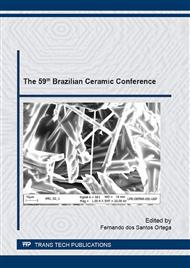p.206
p.212
p.218
p.227
p.233
p.239
p.245
p.251
p.259
Study on the Influence of Water-Reducing Additives in Concretes for Civil Construction
Abstract:
Water-reducing additives for concretes are high efficiency dispersants that promote reduction of viscosity in suspensions, minimizing the amount of water used to hydrate the cement, thus enabling the fabrication of concrete with excellent properties. However, different forms of interaction between cement and additives are observed. In this work the properties of concrete formulated with three dosages of a polycarboxylate-based water-reducing additive and cement type CPII E-32 from two distinct manufacturers were investigated. In the experimental part, we verified the importance to use this technology justified by excellent results obtained for mechanical resistance and plasticity properties of the concretes. Through statistical analysis it was possible to point a discrete superiority in compositions using Holcim cement in function of its physical and chemical characteristics, in which the interaction process showed to be more efficient.
Info:
Periodical:
Pages:
233-238
Citation:
Online since:
November 2016
Keywords:
Price:
Сopyright:
© 2017 Trans Tech Publications Ltd. All Rights Reserved
Share:
Citation:


